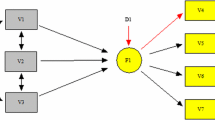Abstract
To assess the reliability of congeneric tests, specifically designed reliability measures have been proposed. This paper emphasizes that such measures rely on a unidimensionality hypothesis, which can neither be confirmed nor rejected when there are only three test parts, and will invariably be rejected when there are more than three test parts. Jackson and Agunwamba's (1977) greatest lower bound to reliability is proposed instead. Although this bound has a reputation for overestimating the population value when the sample size is small, this is no reason to prefer the unidimensionality-based reliability. Firstly, the sampling bias problem of the glb does not play a role when the number of test parts is small, as is often the case with congeneric measures. Secondly, glb and unidimensionality based reliability are often equal when there are three test parts, and when there are more test parts, their numerical values are still very similar. To the extent that the bias problem of the greatest lower bound does play a role, unidimensionality-based reliability is equally affected. Although unidimensionality and reliability are often thought of as unrelated, this paper shows that, from at least two perspectives, they act as antagonistic concepts. A measure, based on the same framework that led to the greatest lower bound, is discussed for assessing how close is a set of variables to unidimensionality. It is the percentage of common variance that can be explained by a single factor. An empirical example is given to demonstrate the main points of the paper.
Similar content being viewed by others
References
Bekker, P.A., & De Leeuw, J. (1987). The rank of reduced dispersion matrices.Psychometrika, 52, 125–135.
Bentler, P.M. (1972). A lower-bound method for the dimension-free measurement of reliability.Social Science Research, 1, 343–357.
Bentler, P.M., & Woodward, J.A. (1980). Inequalities among lower bounds to reliability: With applications to test construction and factor analysis.Psychometrika, 45, 249–267.
Cortina, J.M. (1993). What is coefficient alpha? An examination of theory and applications.Journal of Applied Psychology, 78, 98–104.
Cronbach, L.J. (1951). Coefficient alpha and the internal structure of tests.Psychometrika, 16, 297–334.
Cronbach, L.J. (1988). Internal consistency of tests.Psychometrika, 53, 63–70.
De Leeuw, J. (1983). Models and methods for the analysis of correlation coefficients.Journal of Econometrics, 22, 113–137.
Feldt, L.S., Woodruff, D.J., & Salih, F.A. (1987). Statistical inference for coefficient alpha.Applied Psychological Measurement, 11, 93–103.
Guttman, L. (1945). A basis for analyzing test-retest reliability.Psychometrika, 10, 255–282.
Guttman, L. (1958). To what extent can communalities reduce rank.Psychometrika, 23, 297–308.
Jackson, P.H., & Agunwamba, C.C. (1977). Lower bounds for the reliability of the total score on a test composed of nonhomogeneous items: I. Algebraic lower bounds.Psychometrika, 42, 567–578.
Kristof, W. (1974). Estimation of reliability and true score variance from a split of the test into three arbitrary parts.Psychometrika, 39, 245–249.
Ledermann, W. (1937). On the rank of reduced correlation matrices in multiple factor analysis.Psychometrika, 2, 85–93.
McDonald, R.P. (1970). The theoretical foundations of principal factor analysis, canonical factor analysis, and alpha factor analysis.British Journal of Mathematical and Statistical Psychology, 23, 1–21.
Nicewander, W.A. (1990). A latent-trait based reliability estimate and upper bound.Psychometrika, 55, 65–74.
Novick, M.R., & Lewis, C. (1967). Coefficient alpha and the reliability of composite measurements.Psychometrika, 32, 1–13.
Osburn, H.G. (2000). Coefficient alpha and related internal consistency reliability coefficients.Psychological Methods, 5, 343–355.
Schmitt, N. (1996). Uses and abuses of coefficient alpha.Psychological Assessment, 8, 350–353.
Shapiro, A. (1982a). Rank reducibility of a symmetric matrix and sampling theory of minimum trace factor analysis.Psychometrika, 47, 187–199.
Shapiro, A. (1982b). Weighted minimum trace factor analysis.Psychometrika, 47, 243–264.
Shapiro, A., & Ten Berge, J.M.F. (2000). The asymptotic bias of Minimum Trace Factor Analysis, with applications to the greatest lower bound to reliability.Psychometrika, 65, 413–425.
Shapiro, A., & Ten Berge, J.M.F. (2002). Statistical inference of minimum rank factor analysis.Psychometrika, 67, 79–94.
Spearman, C.E. (1927).The abilities of man. London: McMillan.
Ten Berge, J.M.F. (1998). Some recent developments in factor analysis and the search for proper communalities. In A. Rizzi, M. Vichi, and H.-H. Bock (Eds.):Advances in data science and classification (pp. 325–334). Berlin: Springer.
Ten Berge, J.M.F., & Kiers, H.A.L. (1991). A numerical approach to the exact and the approximate minimum rank of a covariance matrix.Psychometrika, 56, 309–315.
Ten Berge, J.M.F., Snijders, T.A.B., & Zegers, F.E. (1981). Computational aspects of the greatest lower bound to reliability and constrained minimum trace factor analysis.Psychometrika, 46, 357–366.
Van Zijl, J.M., Neudecker, H., & Nel, D.G. (2000). On the distribution of the maximum likelihood estimator of Cronbach's alpha.Psychometrika, 65, 271–280.
Verhelst, N.D. (1998).Estimating the reliability of a test from a single test administration (Measurement and Research Department Report No. 98-2). Arnhem: CITO.
Wilson, E.B., & Worcester, J. (1939). The resolution of six tests into three general factors.Proceedings of the National Academy of Sciences, 25, 73–79.
Woodhouse, B., & Jackson, P.H. (1977). Lower bounds for the reliability of a test composed of nonhomogeneous items II: A search procedure to locate the greatest lower bound.Psychometrika, 42, 579–591.
Yuan, K.-H., & Bentler, P.M. (2002). On robustness of the normal-theory based asymptotic distributions of three reliability coefficient estimates.Psychometrika, 67, 251–259.
Author information
Authors and Affiliations
Corresponding author
Additional information
The authors are obliged to Henk Kiers for commenting on a previous version. Gregor Sočan is now at the University of Ljubljana.
Rights and permissions
About this article
Cite this article
Ten Berge, J.M.F., Sočan, G. The greatest lower bound to the reliability of a test and the hypothesis of unidimensionality. Psychometrika 69, 613–625 (2004). https://doi.org/10.1007/BF02289858
Received:
Revised:
Issue Date:
DOI: https://doi.org/10.1007/BF02289858




